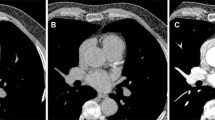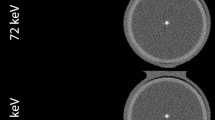Abstract
Clinical cardiac applications of single-source dual-energy computed tomography (DECT) have recently been introduced. This study aimed to analyze the components of coronary arterial calcification (CAC) in vivo by material decomposition achieved with DECT. We reconstructed computed tomography (CT) angiography images for 51 consecutive patients with CACs who had undergone electrocardiography-gated coronary CT angiography by single-source DECT with fast tube voltage switching. We placed regions of interest (ROIs) within the CAC with margins of at least 0.5 mm to minimize partial volume averaging. We compared histograms for the effective atomic number (EAN) and the median, mean, and maximum EANs for each CAC with the theoretical EANs for possible CAC components, including hydroxyapatite (HA), calcium oxalate monohydrate (COM), and dicalcium phosphate dehydrate. We also investigated the in vivo EAN for COM and in vitro EAN for HA by our phantom experiment. Analysis of the CAC components was feasible in 177 ROIs from 28 patients. The median EAN was 13.8 ± 0.8 (95 % confidence interval 13.7–13.9), which is similar to the theoretical EAN for COM (13.8). The EAN for HA in vitro was 16.5 ± 0.1, which was slightly higher than the theoretical EAN value for HA (16.1). Notably, the median EAN in 144 ROIs (81.4 %) was between 11.2 and 14.4, which is the reported range of the in vivo EAN for COM. Our results suggest that COM might be a more frequent CAC component than previously reported.




Similar content being viewed by others
Abbreviations
- ASiR:
-
Adaptive statistical iterative reconstruction
- CABG:
-
Coronary artery bypass graft
- CAC:
-
Coronary arterial calcification
- CAD:
-
Coronary artery disease
- CC:
-
Calcium carbonate
- CI:
-
Confidence interval
- CO:
-
Calcium oxalate
- COM:
-
Calcium oxalate monohydrate
- CT:
-
Computed tomography
- CTA:
-
Computed tomography angiography
- CTDIvol:
-
Volume CT dose index
- DCPD:
-
Dicalcium phosphate dehydrate
- DECT:
-
Dual-energy computed tomography
- DLP:
-
Dose-length product
- EAN:
-
Effective atomic number
- ECG:
-
Electrocardiogram
- HA:
-
Hydroxyapatite
- OCP:
-
Octacalcium phosphate
- ROI:
-
Region of interest
References
Yeboah J, McClelland RL, Polonsky TS, Burke GL, Sibley CT, O’Leary D, Carr JJ, Goff DC, Greenland P, Herrington DM (2012) Comparison of novel risk markers for improvement in cardiovascular risk assessment in intermediate-risk individuals. JAMA 308(8):788–795. doi:10.1001/jama.2012.9624
Margolis JR, Chen JT, Kong Y, Peter RH, Behar VS, Kisslo JA (1980) The diagnostic and prognostic significance of coronary artery calcification. A report of 800 cases. Radiology 137(3):609–616
Carlstrom D, Engfeldt B, Engstrom A, Ringertz N (1953) Studies on the chemical composition of normal and abnormal blood vessel walls. I. Chemical nature of vascular calcified deposits. Lab Invest 2(5):325–335
Lee JS, Morrisett JD, Tung CH (2012) Detection of hydroxyapatite in calcified cardiovascular tissues. Atherosclerosis 224(2):340–347. doi:10.1016/j.atherosclerosis.2012.07.023
Schmid K, McSharry WO, Pameijer CH, Binette JP (1980) Chemical and physicochemical studies on the mineral deposits of the human atherosclerotic aorta. Atherosclerosis 37(2):199–210
Spiers FW (1946) Effective atomic number and energy absorption in tissues. Br J Radiol 19:52–63
Kulkarni NM, Eisner BH, Pinho DF, Joshi MC, Kambadakone AR, Sahani DV (2013) Determination of renal stone composition in phantom and patients using single-source dual-energy computed tomography. J Comput Assist Tomogr 37(1):37–45. doi:10.1097/RCT.0b013e3182720f66
Valentin J (2007) Managing patient dose in multi-detector computed tomography(MDCT). ICRP Publication 102. Annals of the ICRP 37(1):1–79, iii
Fuchs TA, Stehli J, Fiechter M, Dougoud S, Gebhard C, Ghadri JR, Husmann L, Gaemperli O, Kaufmann PA (2013) First experience with monochromatic coronary computed tomography angiography from a 64-slice CT scanner with Gemstone Spectral Imaging (GSI). J Cardiovasc Comput Tomogr 7(1):25–31. doi:10.1016/j.jcct.2013.01.004
Micheletti RG, Fishbein GA, Currier JS, Fishbein MC (2008) Monckeberg sclerosis revisited: a clarification of the histologic definition of Monckeberg sclerosis. Arch Pathol Lab Med 132(1):43–47. doi:10.1043/1543-2165(2008)132[43:MSRACO]2.0.CO;2
Bostrom K, Watson KE, Horn S, Wortham C, Herman IM, Demer LL (1993) Bone morphogenetic protein expression in human atherosclerotic lesions. J Clin Invest 91(4):1800–1809. doi:10.1172/JCI116391
Fitzpatrick LA, Severson A, Edwards WD, Ingram RT (1994) Diffuse calcification in human coronary arteries. Association of osteopontin with atherosclerosis. J Clin Invest 94(4):1597–1604. doi:10.1172/JCI117501
Giachelli CM, Bae N, Almeida M, Denhardt DT, Alpers CE, Schwartz SM (1993) Osteopontin is elevated during neointima formation in rat arteries and is a novel component of human atherosclerotic plaques. J Clin Invest 92(4):1686–1696. doi:10.1172/JCI116755
Doherty TM, Detrano RC (1994) Coronary arterial calcification as an active process: a new perspective on an old problem. Calcif Tissue Int 54(3):224–230
Fishbein GA, Micheletti RG, Currier JS, Singer E, Fishbein MC (2008) Atherosclerotic oxalosis in coronary arteries. Cardiovasc Pathol 17(2):117–123. doi:10.1016/j.carpath.2007.07.002
Arbus GS, Sniderman S (1974) Oxalosis with peripheral gangrene. Arch Pathol 97(2):107–110
Schroeder S, Achenbach S, Bengel F, Burgstahler C, Cademartiri F, de Feyter P, George R, Kaufmann P, Kopp AF, Knuuti J, Ropers D, Schuijf J, Tops LF, Bax JJ (2008) Cardiac computed tomography: indications, applications, limitations, and training requirements: report of a Writing Group deployed by the Working Group Nuclear Cardiology and Cardiac CT of the European Society of Cardiology and the European Council of Nuclear Cardiol. Eur Heart J 29(4):531–556. doi:10.1093/eurheartj/ehm544
Sun Z, Ng KH (2012) Prospective versus retrospective ECG-gated multislice CT coronary angiography: a systematic review of radiation dose and diagnostic accuracy. Eur J Radiol 81(2):e94–100. doi:10.1016/j.ejrad.2011.01.070
Machida H, Masukawa A, Tanaka I, Fukui R, Suzuki K, Ueno E, Kodera K, Nakano K, Shen Y (2010) Prospective electrocardiogram-gated axial 64-detector computed tomographic angiography vs retrospective gated helical technique to assess coronary artery bypass graft anastomosis: comparison of image quality and patient radiation dose. Circ J 74(4):735–740
Murty RC (1965) Effective atomic numbers of heterogeneous materials. Nature 207:398–399
Acknowledgments
We thank Isao Tanaka and Rika Fukui (Department of Radiology, Tokyo Women’s Medical University Medical Center East) for their expert technical assistance. We also thank Takuya Hiramoto (GE Healthcare) for his helpful discussion and technical information on single-source DECT.
Conflict of interest
None of the authors has any potential conflict of interests.
Author information
Authors and Affiliations
Corresponding authors
Rights and permissions
About this article
Cite this article
Matsui, K., Machida, H., Mitsuhashi, T. et al. Analysis of coronary arterial calcification components with coronary CT angiography using single-source dual-energy CT with fast tube voltage switching. Int J Cardiovasc Imaging 31, 639–647 (2015). https://doi.org/10.1007/s10554-014-0574-x
Received:
Accepted:
Published:
Issue Date:
DOI: https://doi.org/10.1007/s10554-014-0574-x




